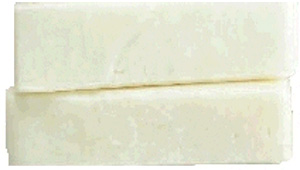Olive Oil Bar Soap Recipe

Regarding preparedness supplies and/or general self-sufficient living, one item that will be important to you is soap. Most people today have no idea where soap comes from (except from ‘the store’). You could choose to stock up with plenty of extra soap, or you might want to know how to make your own, just in case…
There are many many soap recipes out there, which is somewhat of an art form. But for the sake of keeping it simple, here is one basic bar soap recipe using easily available and store-able ingredients; olive oil, Lye, and water.
First though, Lye is a potentially dangerous substance and must be handled with caution. Use proper safety precautions. That means rubber gloves, protective eye-wear, no kids or animals nearby, etc. Never leave mixed lye-water unattended. You must find a safe and secure location for it to cool. Never use Aluminum utensils or pots for soap-making because Lye reacts badly with Aluminum.
Lye is available in many supermarkets and home improvement stores. One common brand name is “Red Devil”, but there are a number of alternative sources for Lye (also known as Sodium Hydroxide), like this one… Food Grade Sodium Hydroxide Lye Micro Beads. Make sure it says “100% Lye” on the container.
How to make olive oil bar soap
Things you will need…
Scale to weigh Lye (or known measure based on the can)
Measuring cup to measure liquid volume
Thermometer to measure lye-water and oil temperature
Stirring spoon or spatula (wood, rubber, or silicon)
Stick blender or hand beater (optional)
Stainless steel or enamel pot for mixing Lye (at least 2 quart size)
Stainless steel or enamel pot for mixing soap (at least 2 gallon size)
Plastic container(s) with lid for the mold (e.g. Rubbermaid, etc.)
(Makes about 10 pounds of soap)
5 cups of Water (distilled if available but not necessary)
20 cups of Olive Oil
18 ounces of Lye
Pour water (5-cups) into the 2-quart pot.
Gently add the Lye and stir carefully with spoon to mix and dissolve.
The mixture will get hot and will produce fumes for a few minutes, so it’s best to mix it and get away from it quickly until the fumes disperse. A ventilated area is recommended.
Set the lye-water mixture aside in a safe place to cool off some (until the container is just warm to the touch).
Pour Olive Oil (20-cups) into the large 2-gallon pot and heat on the stove until Olive Oil is approximately 100 degrees F. Without a thermometer, simply heat until the outside of the pot feels very warm to the touch.
Remove the pot from the heat source.
Very slowly and carefully to avoid spills, pour the lye-water mixture of the smaller pot into the warm oil of the large pot, stirring the oil all the while with your spoon.
The mixture will ‘incorporate’ and become smoother. Continue stirring for a couple of minutes to be sure everything is well-mixed. Then, if available, start using your ‘stick blender’ or beater, for short intervals (30 seconds), being very careful not to splatter the mixture out of the pot. Hand-stir in between intervals.
You will soon notice the mixture getting thicker and more opaque. Keep stirring until you get a rather thick pudding-like consistency.
Mixing times may vary, but if stirring only with a spoon, olive oil soap generally takes at least 45 minutes to ‘trace’, or as fast as 20 minutes with a hand blender. ‘Trace’ is the point when the soap mixture has thickened so that when you dribble a stream over surface, it sits on the surface briefly before melting into the mixture. Kind of like how the consistency of honey will bead and then flatten out.
Pour soap mixture into the mold, snap on lid, and cover with blankets to insulate the soap, which allows the process to continue. The block of soap will heat up a great deal and liquefy again, then cool off slowly and harden.
Leave the block of soap undisturbed for at least 12 hours. It should then become firm to the touch, but don’t remove from the mold if it still feels hot. Wait until it cools completely.
When you remove the soap from the mold, you might notice some condensation on the block. Just leave it, and it will reabsorb into the soap.
Cut the block of soap into bars soon after removing from the mold. Olive Oil makes a very hard soap and it can be difficult to cut without any chipping or breakage if you wait too long.
The soap should be aged for approximately 4 weeks before use as it hardens and loses excess moisture.
